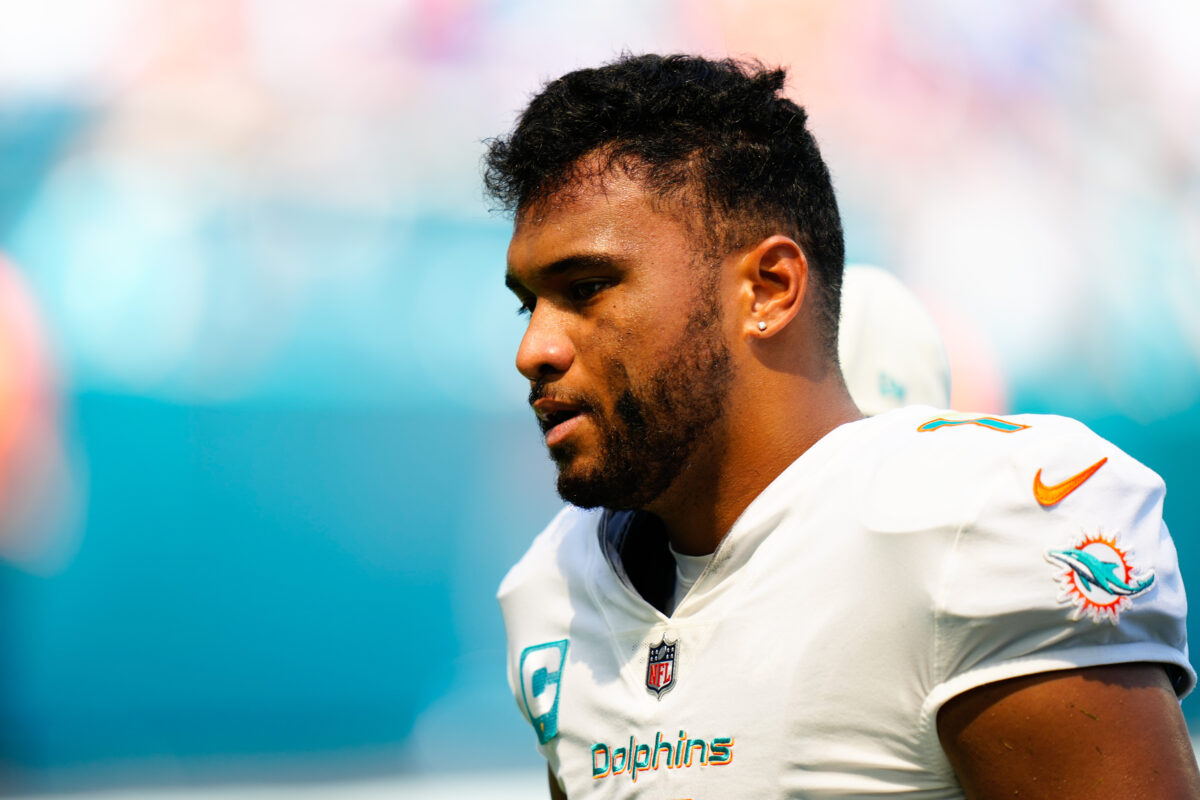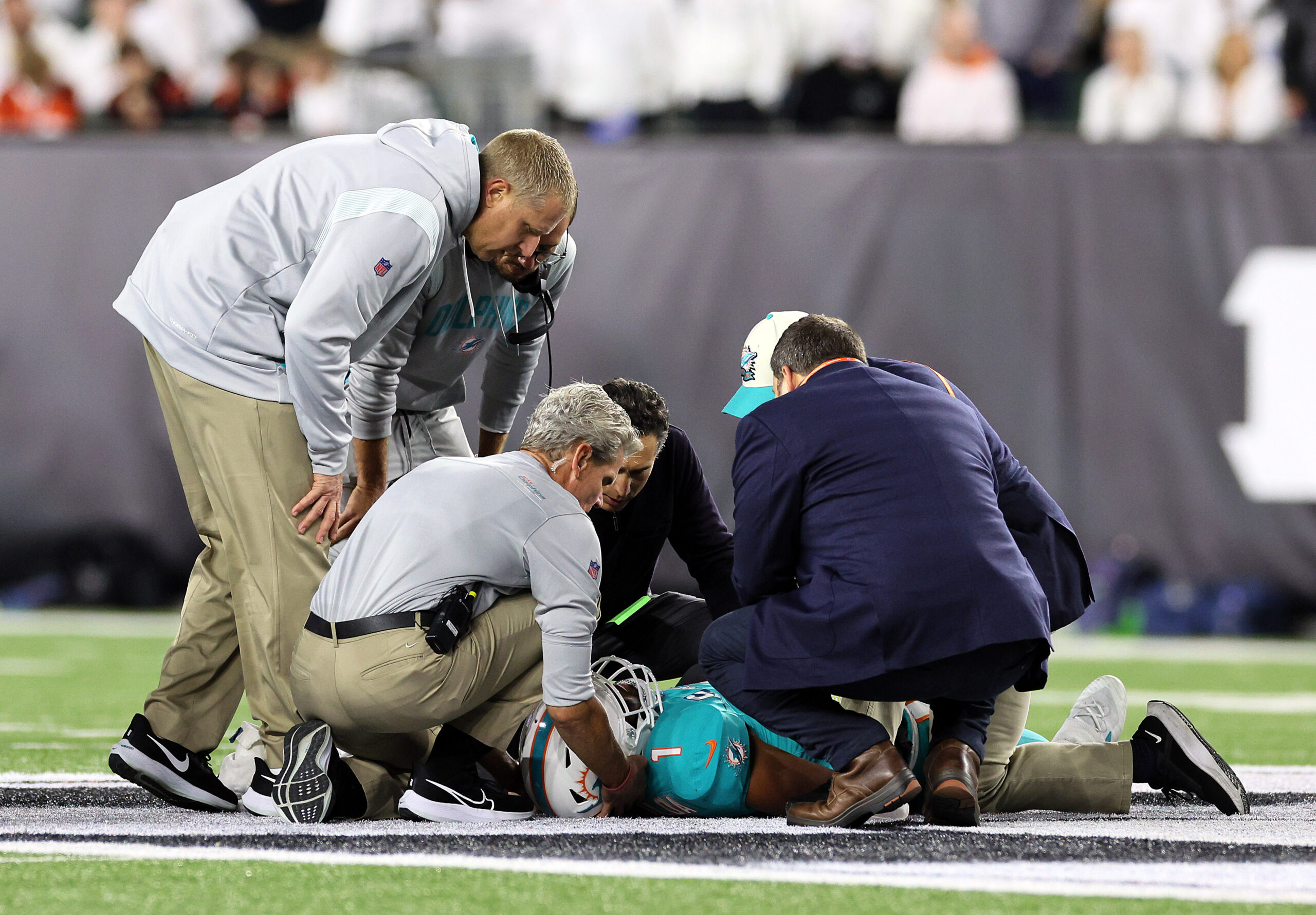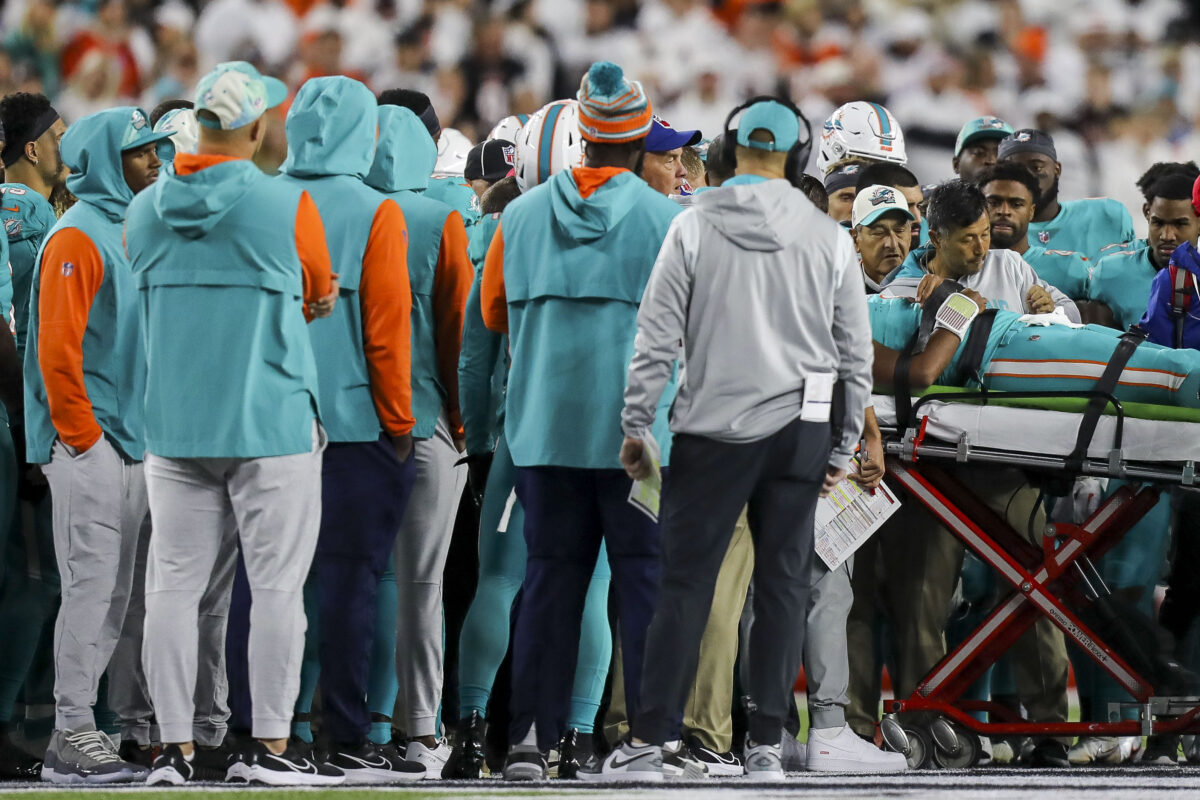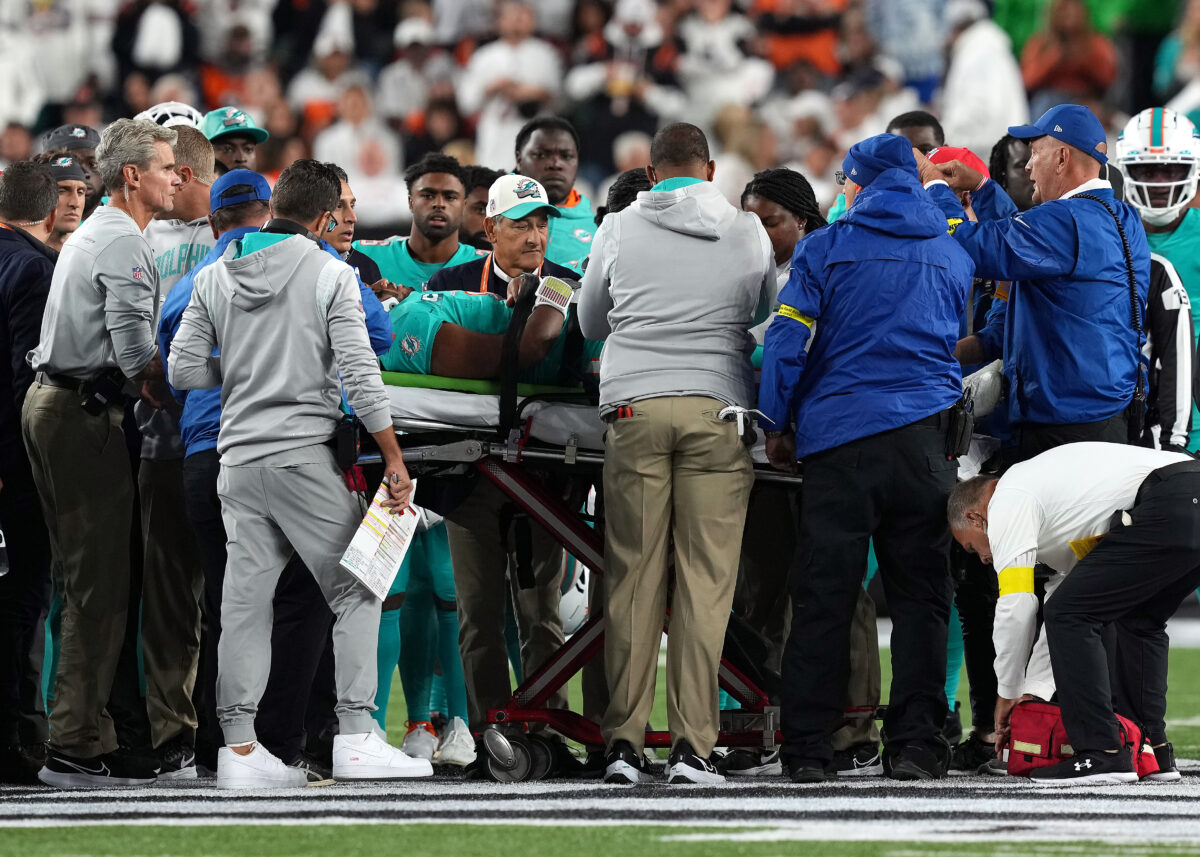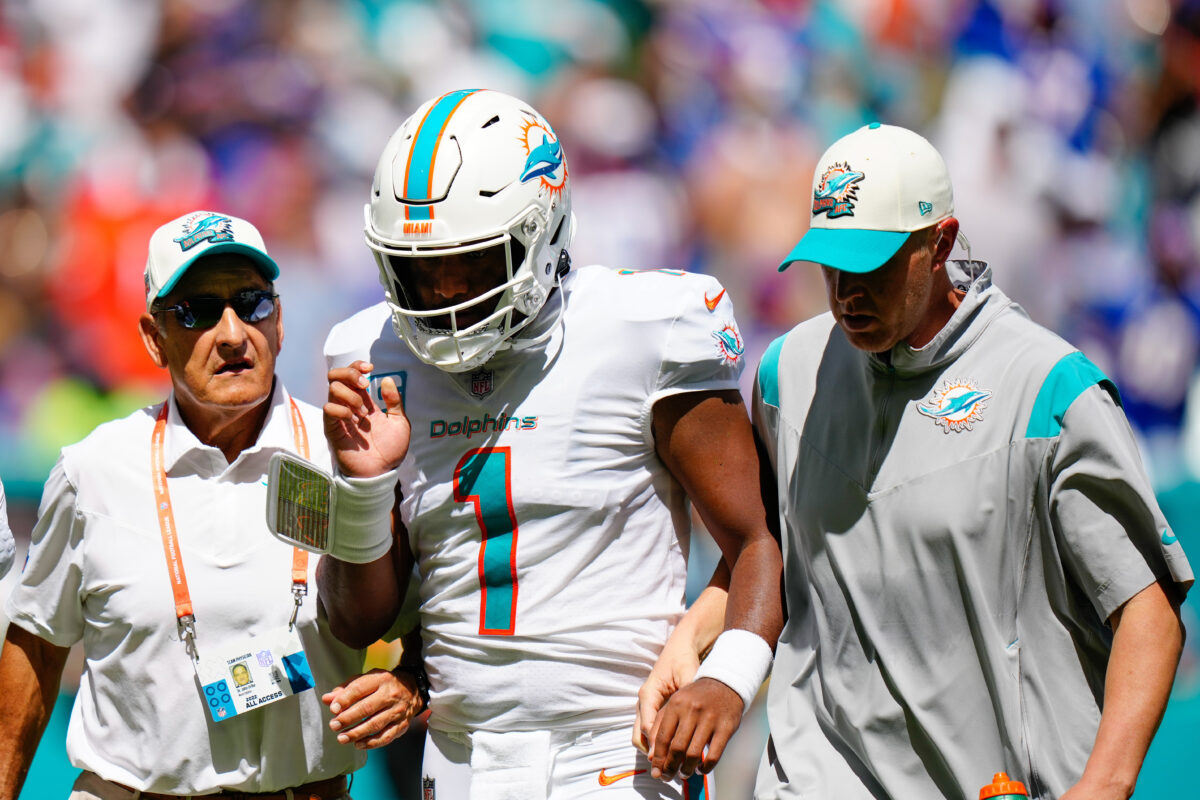The NFL has made all kinds of noise about improved player safety, and the steps the league has taken in that direction. You see it a lot, whether it’s true or not. One thing the NFL did do in recent years was to place Unaffiliated Neurotrauma Consultants (UNC) on the sidelines of every NFL game, as well as another UNC who monitors the broadcast video and audio feeds of each game from the spotters’ booth, and is supposed to notify on-field UNCs of possible head, neck or spine injuries.
The NFL’s current concussion protocol had already failed Miami Dolphins quarterback Tua Tagovailoa this season. Now, it appears that in Miami’s 26-20 Sunday loss to the Green Bay Packers, Tagovailoa was failed again. Tagovailoa was placed back in the concussion protocol today after reporting symptoms, quite possibly based on this tackle by linebacker Kingsley Enagbare in the second quarter.
It's being reported Tua Tagovailoa played the entire second half yesterday with a concussion.
Tua's 2nd Half:
7-13 81 YDS 0 TD 3 INTSAll three interceptions came in the 4th quarter. pic.twitter.com/nHBlLkMpHp
— Albert Nguyen (@AnalyticsCapper) December 26, 2022
Head coach Mike McDaniel mentioned Monday that Tagovailoa was not checked for a concussion at any point in the game.
“This is something that just came across my plate a couple hours ago,” McDaniel said. “As far as the game was concerned, no one recognized anything with regard to any sort of hit. I can’t really tell you exactly what it was. I’m not totally positive on that, but it was something that he met with the doctors today and discussed some symptoms and then from that, as you guys know, from there on, that’s between Tua and the doctors and we’ll move forward as information is projected towards us.
“As much as I know, he’s displayed symptoms and they [team doctors] enacted the protocol, which is all that needs to happen before you have to, by the player’s health, go through that whole process as they should, so it’s a little early. Like I said, I only found out a couple hours ago.”
On the second of Tagovailoa’s three fourth-quarter interceptions, Tagovailoa detailed after the game what was an obvious miscommunication by saying, “I might have said the wrong play. I’m not too sure. But there was just some communication errors on that.”
Which might have been cause for concern right there. Asked about the team’s and his own accountability for Tagovailoa’s health, McDaniel said all the right things, and also pointed to the massive holes in the process.
“You’re always accountable for it. The bottom line was collectively, guys that we’ve really relied upon all season had a – it’s a fast-paced decision that you get one shot at, and they collectively didn’t think that there was information enough to overturn it. Now you go and look back at it, I know there’s some assessment by people outside the league that have formerly been in the league. I’m aware of that. I’ll be interested to see what the league has to say. But I think you do it like everything else with regard to head-coaching responsibilities – you don’t just ever blow anything off, regardless of if it works in your favor or not. We’re always talking through, trying to get better at stuff so that the one thing you can control is not have something happen twice that maybe didn’t work out in your favor. So I’m happy with the guys that we work with and I expect that process to continually get better, regardless of what happens in the immediate.”
What’s especially shameful about this miss is that the NFL was supposed to have “improved” its concussion protocol after everybody missed Tagovailoa’s obvious concussion symptoms in Week 3, when the Dolphins faced the Buffalo Bills. Tagovailoa was permitted to return to action after this hit.
This is what happened to Tua Tagovailoa after his head hit the turf hard. Not sure how you let him back in.
(🎥 @EmmanuelAcho)pic.twitter.com/OiAJwaN5RI
— Ari Meirov (@MySportsUpdate) September 25, 2022
The NFLPA announced that it would review the process after that, and the UNC responsible for clearing Tagovailoa to play was subsequently fired by the NFLPA, which has unilateral authority to do so if it deems the action appropriate. In this case, it was, as the UNC had made “several mistakes.”
Team doctors cleared Tagovailoa to play just four days after that, in Miami’s Week 4 Thursday night game against the Cincinnati Bengals. Late in the first half of that game, Tagovailoa went into what it known as a “fencing response position” after another hit to his head.
What is a ‘fencing response position’ following head trauma?
It is “an overt indicator of injury force magnitude and midbrain localization to aid in injury identification and classification,” according to the National Library of Medicine. This time, the Dolphins released a statement during the game that Tagovailoa had suffered head and neck injuries and was being taken to the University of Cincinnati Hospital. Reports indicated that Tagovailoa had movement in all his extremities.
The NFL and NFLPA agreed to modify its concussion protocol after all that. From then on, any player showing signs of ataxia – an abnormality of balance/stability, motor coordination or dysfunctional speech caused by a neurological issue – is prohibited from returning to a game.
Not that this would have helped Tagovailoa in the Packers game. He would have had to rely on spotters who were seemingly unable to spot anything.
In 2016, The NFL and NFLPA announced a new policy to enforce the concussion protocol. The new policy was said to implement a “strict and fair” process that investigates incidents regarding concussion protocol and what discipline will be enacted.
- A first violation by a team will require team employees or medical team employees to attend a remedial education and/or the team will pay a maximum fine of $150,000.
- A second violation will result in a minimum fine of $100,000 against the team.
- If it is agreed that a violation involved aggravating circumstances, the team will be subject to a fine of no less than $50,000.
- If the NFL Commissioner determines that a medical team failed to follow the protocol in order to win a game, the Commissioner can require the team to forfeit draft picks and impose fines that can exceed the amounts above.
The NFL and NFLPA determined that the Dolphins followed concussion protocol before, saying in a statement that “The outcome in this case was not what was intended when the protocol was drafted.”
Obviously not.
Whether the Dolphins are penalized for this instance, or whether another UNC is fired after an investigation, the larger issue is that a 24-yard-old person, in his third NFL season, has been betrayed by the NFL’s concussion policies over and over, and the determination has been that the NFL did nothing wrong.
That should frighten Tagovailoa, as much as it should frighten any NFL player who could be easily and similarly betrayed by the league’s health and safety guidelines.
Sadly, any NFL player is only a few unfortunate hits away from a similar situation.
